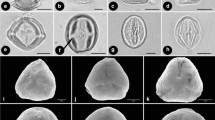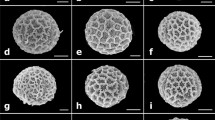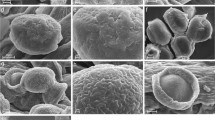Abstract
The pollen morphology and distribution of orbicules were investigated in ten species of the genus Coptosapelta (Rubiaceae) using light, scanning electron and transmission electron microscopy. In general, Coptosapelta pollen is three- to five-pororate and suboblate to oblate-spheroidal. The sexine ornamentation varies from psilate to reticulate, and the pollen-wall stratification lacks columellae. ‘Droplets’ are observed on the inner nexine surface. Distinct orbicules are found in five species. Orbicules are often lobed and appear to be aggregated and embedded in the tapetal remnants of the locule wall. Ultrastructurally, a single, flattened core is frequently observed. Coptosapelta has a unique pollen type within Rubiaceae and does not resemble possibly related genera. Pollen characteristics provide additional evidence supporting earlier findings that Coptosapelta represents an isolated lineage in Rubiaceae.








Similar content being viewed by others
References
Andersson L, Persson C (1991) Circumscription of the tribe Cinchoneae (Rubiaceae)—a cladistic approach. Plant Syst Evol 178:65–94
Bremekamp CEB (1966) Remarks on the position, the delimitation and the subdivision of the Rubiaceae. Acta Bot Neerl 15:1–33
Bremer B, Manen JF (2000) Phylogeny and classification of the subfamily Rubioideae (Rubiaceae). Pland Syst Evol 211:71–92
Bremer B, Jansen RK, Oxelman B, Backlund M, Lantz H, Ki-Joong K (1999) More characters or more taxa for a robust phylogeny—case study from the coffee family (Rubiaceae). Syst Biol 48:413–435
Buchner R, Puff C (1993) The genus complex Danais-Schismatoclada-Payera (Rubiaceae). Character states, generic delimitation and taxonomic position. Bull Mus Natl B. Adansonia 1–4:23–74
Dessein S, Huysmans S, Robbrecht E, Smets E (2002) Pollen of African Spermacoce species (Rubiaceae): morphology and evolutionary aspects. Grana 41:69–89
Erdtman G (1952) Pollen morphology and plant taxonomy; angiosperms. Almqvist & Wiksell, Stockholm
Erdtman G (1971) Pollen morphology and plant taxonomy: angiosperms. Hafner, New York
Fukuoka N (1980) Studies in the floral anatomy and morphology of Rubiaceae IV. Rondeletieae and Cinchoneae. Acta Phytotaxon Geobot 31:65–71
Govaerts R (1996) World checklist of seed plants, vol 2. Continental Publ, Antwerp
Holmgren PK, Holmgren NH, Barnett LC (1990) Index herbariorum, part 1. The herbaria of the world, 8th edn. Regnum vegetabile 120. New York Botanical Garden, New York
Hooker JD (1873) Ordo LXXXIV. Rubiaceae. In: Bentham G, Hooker JD (eds) Genera plantarum ad exemplaria imprimis in herbariis kewensibus servata defirmata. London
Huang TC (1972) The pollen flora of Taiwan. Botany Department Press, National Taiwan University
Huysmans S (1998) Palynology of the Cinchonoideae (Rubiaceae). Morphology and development of pollen and orbicules. PhD thesis, Institute of Botany and Microbiology, K.U. Leuven, Leuven
Huysmans S, Robbrecht E, Smets E (1994) Are the genera Hallea and Mitragyna (Rubiaceae-Coptosapelteae) pollen morphologically distinct? Blumea 39:321–340
Huysmans S, El-Ghazaly G, Nilsson S, Smets E (1997) Systematic value of tapetal orbicules: a preliminary survey of the Cinchonoideae (Rubiaceae). Can J Bot 75:815–826
Jansen S (1994) Een houtanatomische en palynologische studie van Psychotrieae (Rubiaceae-Rubioideae). PhD thesis, Institute of Botany and Microbiology, K.U. Leuven, Leuven
Jansen S, Dessein S, Piesschaert F, Robbrecht E, Smets E (2000) Aluminium accumulation in leaves of Rubiaceae: systematic and phylogenetic implications. Ann Bot 85:91–101
Jansen S, Robbrecht E, Beeckman H, Smets E (2002) A survey of the systematic wood anatomy of the Rubiaceae. IAWA J 23:1–67
Jansen S, Watanabe T, Dessein S, Smets E, Robbrecht E (2003) A comparative study of metal levels in leaves of some Al-accumulating Rubiaceae. Ann Bot 91:657–663
Metcalfe CR, Chalk L (1950) Anatomy of the dicotyledons. Clarendon Press, Oxford
Persson C (1993) Pollen morphology of the Gardenieae-Gardeniinae (Rubiaceae). Nord J Bot 13:561–582
Puff C, Robbrecht E, De Block P (1996) A survey of secondary pollen presentation in Rubiaceae. In: Robbrecht E, Puff C, Smets E (eds) Proc 2nd Int Rubiaceae Conf. Opera Bot Belg 7
Punt W, Blackmore S, Nilsson S, Le Thomas A (1994) Glossary of pollen and spore terminology. LPP Foundation, Utrecht
Reitsma T (1969) Size modifications of recent pollen grains under different treatments. Rev Palaeobot Palynol 69:23–47
Robbrecht E (1977) The indumentum of Coptosapelta Korthals (Rubiaceae). Bull Jard Bot Natl Belg 47:258–259
Robbrecht E (1988) Tropical woody Rubiaceae. Opera Bot Bel 1
Schols P, Dessein S, D’hondt C, Huysmans S, Smets E (2002) Carnoy: a new digital measurement tool for palynology. Grana 41:124–126
Sotolongo Molina L (2002) Pollen morphology of some Cuban Guettarda species (Rubiaceae: Guettardeae). Grana 41:142–148
Thanikaimoni G (1986) Pollen apertures: form and function. In: Blackmore S, Ferguson IK (eds) Pollen and spores, form and function. Linnean Soc Symp Ser 12. Academic Press, London
Valeton T (1923) Het Rubiaceën-geslacht Coptosapelta Korth. Proc Sect Sci K Ned Akad Wet 32:423–440
Van Campo M (1976) Patterns of pollen morphological variation within taxa. In: Ferguson IK, Muller J (eds) The evolutionary significance of the exine. Linnean Soc Symp Ser 1:125–137
Van Steenis CGGJ (1969) Some comments concerning the reduction of the genus Thysanospermum to Coptosapelta (Rubiaceae). Am J Bot 56:805–807
Verdcourt B (1958) Remarks on the classification of the Rubiaceae. Bull Jard Bot Natl Belg 28:210–290
Vinckier S, Smets E (2002) Morphological and ultrastructural diversity of orbicules in relation to evolutionary tendencies in Apocynaceae s.l. Ann Bot 90:647–662
Vinckier S, Huysmans S, Smets E (2000) Morphology and ultrastructure of orbicules in the subfamily Ixoroideae (Rubiaceae). Rev Palaeobot Palynol 108:151–174
Walker JW, Doyle JA (1975) The bases of angiosperm phylogeny: palynology. Ann Mo Bot Gard 62:664–723
Acknowledgements
We are grateful to Steven Jansen for critical review and constructive comments on the paper. We are also grateful to the keepers of bm, br, k, l, ny and p for the loan of herbarium material and their approval to extract material. We thank Marcel Verhaegen for making the SEM pictures and Prof. Billen (Laboratory for Entomology, Catholic University of Leuven) for access to the TEM. This research is supported by a grant from the research council of the K.U.Leuven (OT/01/25) and by a grant from the Fund for Scientific Research – Flanders (1.5.069.02).
Author information
Authors and Affiliations
Corresponding author
Rights and permissions
About this article
Cite this article
Verellen, J., Smets, E. & Huysmans, S. The remarkable genus Coptosapelta (Rubiaceae): pollen and orbicule morphology and systematic implications. J Plant Res 117, 57–68 (2004). https://doi.org/10.1007/s10265-003-0128-0
Received:
Accepted:
Published:
Issue Date:
DOI: https://doi.org/10.1007/s10265-003-0128-0




